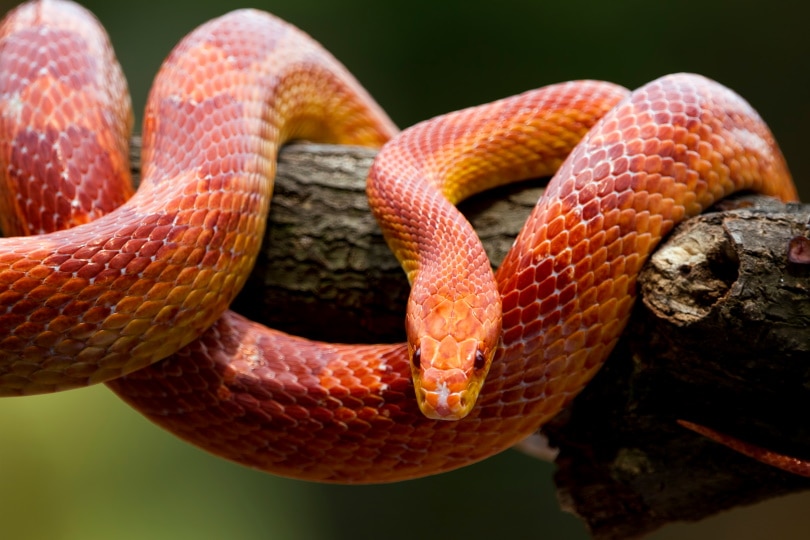

Corn snakes are one of the most popular pet reptiles because of their gorgeous colors, docile personalities, and low maintenance. The red corn snake is especially popular because the red color is vibrant and stunning to look at.
Even though red corn snakes are considered low-maintenance pets, you still have to know the proper care tips when dealing with this delicate creature. Read on to find out facts and information related to owning a red corn snake as a pet.
Quick Facts about Red Corn Snake
| Species Name: | Pantherophis guttatus |
| Common Name: | Corn snake |
| Care Level: | Beginner |
| Lifespan: | 6-8 in the wild, 15-20 years in capacity |
| Adult Size: | 8-12 inches |
| Diet: | Small rodents |
| Minimum Tank Size: | 20-gallon terrarium |
| Temperature & Humidity
|
Warm side: mid 80s Cool side: low 70s Humidity: 30%-50% |
Do Red Corn Snake Make Good Pets?

In comparison to many snakes, red corn snakes make good pets. These snakes are attractive to look at, and they are also docile and gentle. Additionally, adult corn snakes are not too big for regular handling. They are especially great for beginners.
Appearance
Corn snakes come in many colors and patterns, all of which are vibrant. The red corn snake is a particularly popular choice because the scales are bright red, making the snake easy to spot.
Red corn snakes can come in different patterns as well. The pattern simply depends on the individual snake. The variation in appearance means that nearly all red corn snakes are one of a kind.
How to Take Care of Red Corn Snakes
Taking care of a red corn snake isn’t that difficult if you have the right tools and knowledge in your arsenal. They require specific temperature, humidity, and lighting. Once you set up the enclosure, maintenance is pretty easy.
Habitat, Tank Conditions & Setup
The most difficult part of owning a red corn snake, or any other reptile for that matter, is setting up the habitat properly. These creatures are cold blooded, meaning they have more extensive habitat requirements than creatures that regulate their body temperature.
Tank
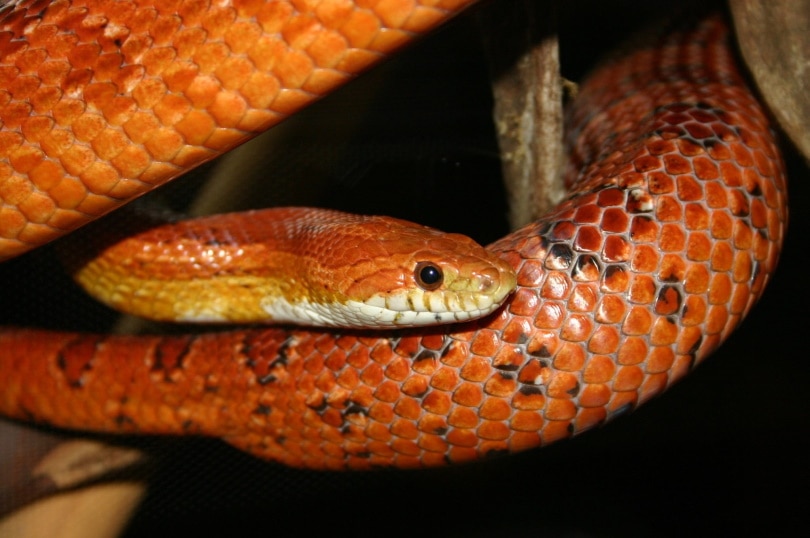
Begin by selecting the right vivarium. When it is a juvenile, you can select a plastic by vivarium about the size of a shoebox. Adult corn snakes will need a 20 gallon reptile terrarium or bigger. Do not put more than one snake in the terrarium, no matter how large it is.
It is critical to make sure that the terrarium you select is escape proof. Corn snakes are known to be quite the escape artists, and the last thing you want is to have a snake on the loose in your home.
Additionally, create an interior that replicates the snake’s natural environment. Add some climbing branches and hiding spots. Place a bowl of fresh water large enough for the snake to soak into in the tank.
Lighting
Lighting is another important aspect of the snake’s tank conditions. It’s important that the corn snake has access to natural lighting. So long as the snake gets lights that replicate the natural cycle outside, you don’t need additional light.
We recommend placing the vivarium somewhere that natural light can seep into the tank. However, do not place the cage in direct sunlight because that can make the tank too hot.
Heating (Temperature & Humidity)
One aspect of the terrarium you will need to monitor carefully is the temperature. There needs to be a temperature gradient made with either a light or under tank heating pad.
Have a warm side that is around 85 degrees and a room temperature side for the cool end (low 70s). We also recommend placing a pipe or hollow log that runs through the center of the cage so that there is a hiding spot on both the warm and cool.
As for humidity, shoot between 30% and 50%, which is common for most households. We recommend increasing the humidity simply by adding damp moss or damp paper towel to the enclosure. Do this especially whenever the snake is preparing to shed.
Substrate
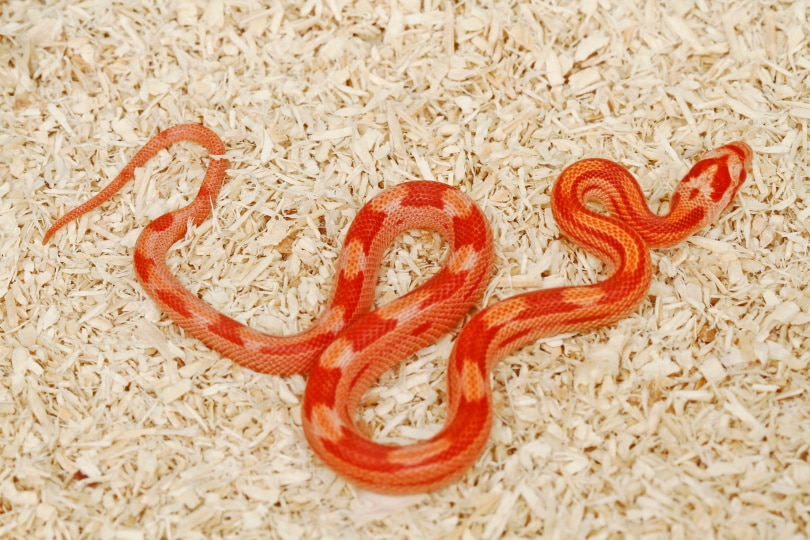
On the terrarium floor, add aspen shavings. Aspen shavings are absorbent and soft. Cypress shavings work too, but do not use woods like pine or cedar because they’re too aromatic. We do not recommend sand, newspaper, or paper towels.
| Tank Recommendations | |
| Tank Type | 20-gallon glass terrarium |
| Lighting | Natural lighting is fine |
| Heating | Heating pad on one side of the enclosure |
| Best Substrate | Aspen bedding |
Feeding Your Red Corn Snake
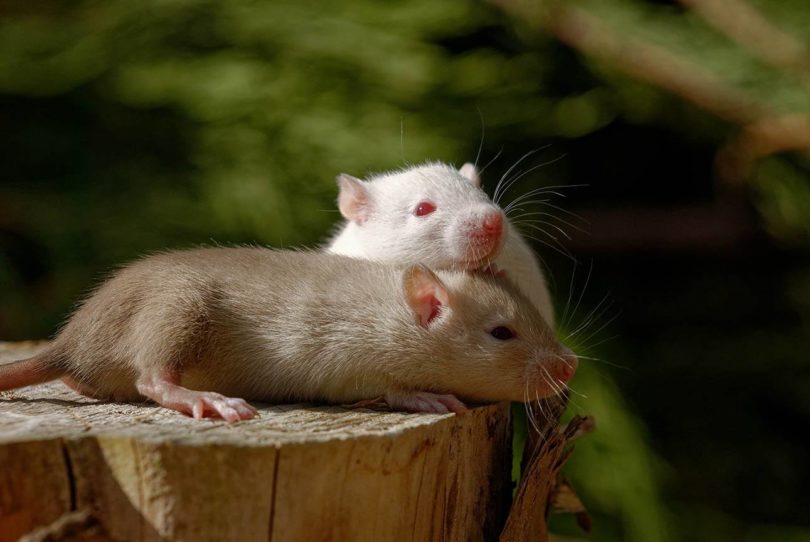
Red corn snakes eat rodents, lizards, frogs, and birds in the wild. In captivity, we recommend feeding your snake a frozen mouse. Crickets and other insects are not suitable for red corn snakes because the snake will not recognize the insects as food.
| Diet Summary | |
| Meat | 100% of diet – small/medium sized rodents, thawed or live |
| Supplements Required | N/A |
Keeping Your Red Corn Snake Healthy
Keeping your red corn snake healthy is not that difficult of a task. So long as you provide it a safe environment and proper diet, it should be safe. Importantly, make sure that the humidity and temperature within the tank is ideal for snakes.
Too much humidity leads to several issues common in red corn snakes, such as respiratory infections, scale rot, and infections in the mouth. At the same time, too low humidity leads to issues like shedding properly.
Common Health Issues
Here are some common health issues to be aware of:
- Bite wounds (from prey)
- Cloacal prolapse
- Constipation
- Dysecdsis
- Parasites
- Respiratory infection
- Retained eggs
- Scale rot
- Stomatitis
Lifespan
In the wild, corn snakes typically live between 6 and 8 years. Because snakes in captivity experience fewer threats and more comprehensive care, red corn snakes often live between 15 and 20 years in captivity.
Not only can these snakes live for a long time in captivity, but they can reproduce for most of these years too. Most corn snakes can reproduce well into their teen years if they last that long.
Breeding
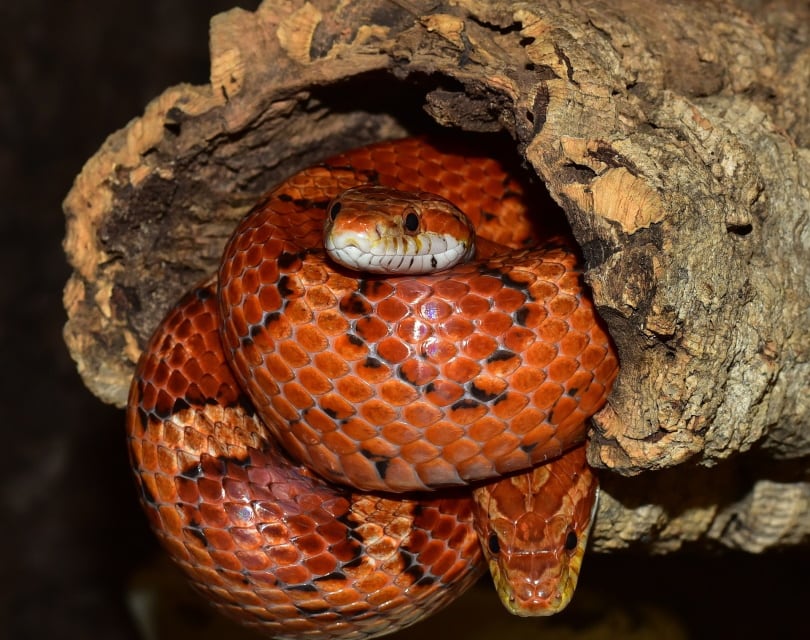
Breeding red corn snakes requires you to sex the specimens and create the perfect environment for breeding. Temperature and photoperiod are two important factors that cause corn snakes to reproduce. In other words, expose the snakes to lower temperatures and shorter days.
Create a cool season that lasts 60 to 75 days. The temperature should be between 45 and 65 degrees Fahrenheit. Once the cool period is over, gradually increase the temperature, light exposure, and humidity. Ideally, the snakes would reproduce on their own after the cool period is over.
Add a nesting box if there are signs the snakes mated. Corn snakes usually lay eggs 30 to 45 days after matting. Remove the eggs once they are laid.
Are Red Corn Snake Friendly? Our Handling Advice
In comparison to many other snakes, red corn snakes are friendly and suitable as pets. Hatchlings will become defensive and should not be held. However, adult snakes will grow accustomed to being handled, even though they don’t particularly seek it out.
Even if the corn snake is defensive, you have little to worry about in terms of it hurting you. Regular house cats are more dangerous than corn snakes. Still, make sure to be gentle yet confident with the snake so you can ease its anxieties.
Do not handle the snake the first week or two you bring it home. Instead, give it time to adjust to its new environment.
Shedding & Hibernation: What to Expect
In the wild, red corn snakes go through a period of hibernation that is brought on by natural signals. In captivity, hibernation only comes about if the temperature and light exposure are diminished. For this reason, your corn snake may not hibernate at all.
If your snake does hibernate, leave it alone until it the period is over. At that point, the snake will shed. Even if your snake does not hibernate, expect it to shed 2 to 6 times a year. When you notice your snake beginning to shed, increase humidity to make the process easier. Remove all dead skin once shedding is complete.
How Much Do Red Corn Snakes Cost?
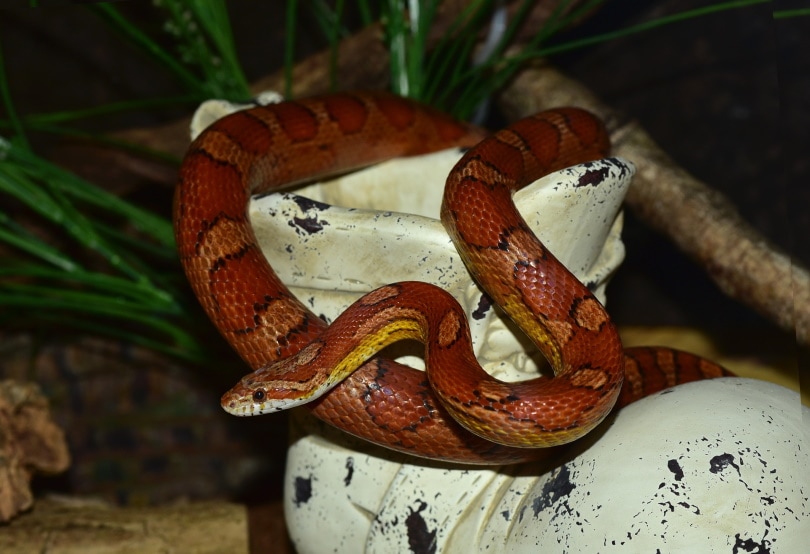
Because corn snakes are such a popular pet snake, you can easily find them at many exotic pet stores. The commonality of these snakes also means that they are more affordable than many other types of reptiles. You should be able to find red corn snakes for about $50 to $100.
Care Guide Summary
Red Corn Snake Pros
- More docile around humans
- Not very dangerous
- Perfect size
Red Corn Snake Cons
- Must be housed individually
- Needs time to adjust to a new environment

Conclusion
If you are interested in getting a pet snake, red corn snakes are a great place to start. These snakes are very fun looking, and they are more comfortable around people than many other snakes. Plus, they are not as difficult to take care of.
So long as you follow our instructions above, you should find owning a red corn snake a fun and relatively easy experience.
Featured Image Credit: Kurit afshen, Shutterstock
Nicole is the proud mom of Baby, a Burmese cat and Rosa, a New Zealand Huntaway. A Canadian expat, Nicole now lives on a lush forest property with her Kiwi husband in New Zealand. She has a strong love for all animals of all shapes and sizes (and particularly loves a good interspecies friendship) and wants to share her animal knowledge and other experts’ knowledge with pet lovers across the globe.






